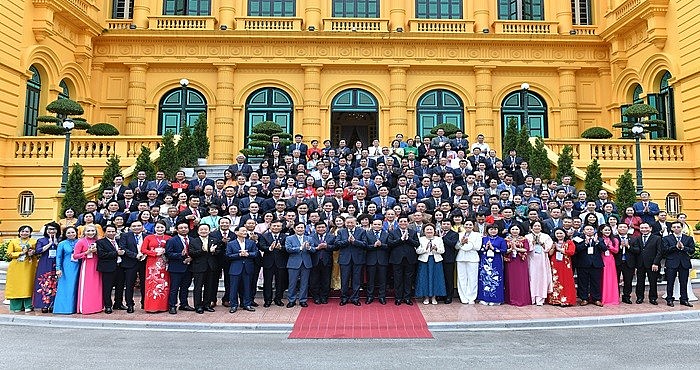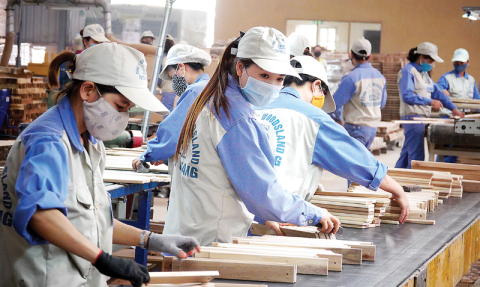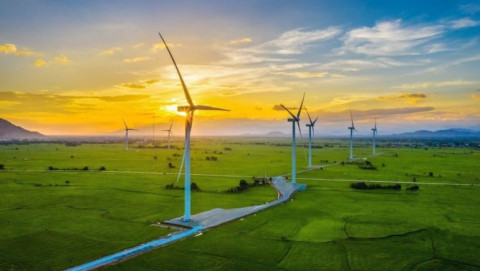Practical application of carbon credits to the economy. Part II: Building infrastructure in the fight against climate change
- 128
- Socially Responsible Enterprise
- 09:29 17/06/2024
DNHN - In the fight against climate change, the carbon credit system has become an important tool for measuring and reducing emissions. Therefore, infrastructure is necessary to ensure transparency in the trading of carbon credits.

Carbon credit infrastructure is an important tool
A strong and high-quality carbon credit infrastructure is essential for ensuring the transparency and reliability of the system. These infrastructures provide the tools and processes for recording, verifying, and tracking the carbon emissions that are reduced and eliminated. This ensures that the carbon credits generated and traded are accurate and have real value.
Thus, carbon credit infrastructure must have the capability to manage data and information related to carbon emissions. This includes collecting, storing, processing, and analyzing data from various sources. Effective data management helps ensure the accuracy and consistency of information, thereby enhancing the ability to assess and monitor carbon emission reduction progress.
A key element in carbon credit infrastructure is independent verification and review. Independent certification organizations are responsible for evaluating and verifying that carbon reduction projects meet established standards and regulations. This ensures fairness and reliability in the trading of carbon credits.
Carbon credit infrastructure provides support mechanisms for carbon reduction projects. This includes providing information, technical advice, and financial support to encourage and promote these projects. This support helps ensure that carbon reduction projects are effectively implemented and achieve the desired results.
Additionally, carbon credit infrastructure needs the ability to link with existing carbon credit markets. This facilitates flexible and efficient trading of carbon credits. Such links also open up opportunities for businesses and organizations to participate in the global market and leverage business opportunities related to carbon credits.
Moreover, carbon credit infrastructure should offer training and educational programs to raise awareness about climate change and the role of carbon credits. This helps create a knowledgeable and aware community about environmental issues, thereby encouraging active and innovative participation in reducing carbon emissions.
Vietnam has signed international commitments to reduce greenhouse gas emissions. The goal is to reduce greenhouse gas emissions by 27% by 2030 compared to the usual development scenario. Greenhouse gas inventory is an important activity to identify the amount of greenhouse gases emitted from various sources, providing a basis for proposing emission reduction solutions.
Mandatory greenhouse gas inventory for enterprises
According to Decision 01/2023/QD-TTg by the Prime Minister, 1,912 enterprise facilities are required to conduct greenhouse gas inventories. From 2024 onwards, businesses will conduct facility-level greenhouse gas inventories, prepare periodic biennial greenhouse gas inventory reports, and submit them to the provincial People's Committee for appraisal before sending them to the Ministry of Natural Resources and Environment.
There are specific legal documents by the Government regulating this, such as Decision 01/2022/QD-TTg on the list of sectors and facilities required to conduct greenhouse gas inventories, Decision 2626/QD-BTNMT on the publication of emission factors for inventory purposes, and Circular 17/2022-BTNMT on measurement, reporting, verification of greenhouse gas emission reductions, and waste management sector’s greenhouse gas inventory techniques.
Thus, facilities can proactively conduct greenhouse gas inventories with the support of these decisions and circulars. Specifically, the greenhouse gas inventory will be conducted in 2024 (completed before January 2025), and the greenhouse gas inventory report will be submitted in 2025 (completed before April 2025).
The greenhouse gases that need to be inventoried include carbon dioxide (CO2), methane (CH4), nitrous oxide (N2O), and hydrofluorocarbons (HFCs). Other greenhouse gases such as sulfur hexafluoride (SF6), perfluorocarbons (PFCs), and nitrogen trifluoride (NF3), depending on the specifics and conditions of each sector, should be considered for inventory.
Upon completing the greenhouse gas inventory, the results will provide a basis for determining the scope of greenhouse gas emissions per unit of product for business and production facilities. The allocation of greenhouse gas emission quotas at facilities will be carried out from 2026-2030 and in subsequent years.
According to statistics from the Ministry of Natural Resources and Environment, the total greenhouse gas emissions from Vietnam's production facilities in 2022 were 662.6 million tons of CO2 equivalent. Emissions from production facilities accounted for about 35%. Greenhouse gas emissions from the cement production sector accounted for about 10% of the total, while the steel production sector accounted for 8%, and the road transport sector accounted for about 25%.
With the rapid pace of urbanization and industrialization, Vietnam will need to expand bridge and infrastructure projects over the next 10 years. This will lead to increased greenhouse gas emissions due to the use of fossil fuels and intensified resource exploitation. According to estimates by the Ministry of Transport, from 2023-2030, Vietnam will need to invest approximately 1,200 trillion VND in bridge and infrastructure projects. Without solutions to reduce greenhouse gas emissions, the expansion of these projects could increase Vietnam's greenhouse gas emissions by about 20%.
Phan Nguyen An
Related news
#entrepreneur

Hoàng Hải Anh and his young peers launch MR. Burgers – a Halal dining destination in Hanoi
At the age of 18, Hoàng Hải Anh (Haris) and his friends have introduced MR. Burgers, bringing the clean Halal food experience to visitors in Hanoi.

Women entrepreneurs in the Era of National Advancement
The economic forum "Women Entrepreneurs in the Era of National Advancement" aims to honor the role of female leaders, promote collaboration, and connect the business community.

The move of a Chinese businesswoman into Vietnam’s snack market
Recognizing Vietnam’s market potential, Chinese entrepreneur Liu Gengyan aims to develop a professional and distinctive snack store chain in the country.

Young entrepreneur Lisa Phan: When you dream and act, nothing is impossible
Lisa Phan believes that a company’s success comes not only from good products and services but also from the way people treat one another.

The role of female entrepreneurs in economic development
In the context of globalization, the role of female entrepreneurs in Vietnam has become increasingly important. They not only contribute to the economy but also drive growth.

Expectations for businesses to play a greater, more significant role in the nation’s prosperity
In the future, by 2045, whether our country can become a developed industrial nation with high income depends on the dedication of today's and future entrepreneurs.
Đọc thêm Socially Responsible Enterprise
When artists do business – livelihood is no poetry!
A series of indictments, arrests, and bankruptcies among artists has sounded a serious alarm.
Hanoi’s economy grows 7.92% in first nine months of 2025, FDI surges nearly threefold
Hanoi maintained robust growth momentum in the first nine months of 2025 with GRDP up 7.92% year-on-year, driven by strong services and construction sectors.
Vietnam’s strong gdp growth fails to ease labor market distress
As the year draws to a close, the pressing challenge for businesses and policymakers is how to rebuild worker morale, retain top talent, and stabilize employment amid lingering uncertainty.
Vietnam ramps up efforts to lift EU “Yellow Card” on Illegal fishing
Prime Minister Pham Minh Chinh has called for intensified and coordinated efforts to have the European Commission’s “yellow card” on Vietnam’s fisheries removed within this year.
Quang Tri calls for investment in wind power plant project worth over VND 1,100 billion
The People’s Committee of Quang Tri Province has officially announced the Hưng Bắc Wind Power Plant Project as part of its investment invitation portfolio.
Hanoi receives two million visitors during the four-day National Day holidays
From August 30 to September 2, Hanoi received around 2.08 million visitors during the four-day National Day holidays , three times higher than the figure in the same period last year, the municipal Department of Tourism reported.
Ca Mau gradually makes its mark on the national tourism map
By 2025, Ca Mau aims to attract 8.4 million visitors and achieve a total revenue exceeding 8,585 billion VND, contributing to the province's double-digit growth target.
UNDP Resident Representative hails Vietnam as an emerging economic powerhouse
Millions of people have been lifted out of poverty, hunger has been eliminated, and the economy has maintained consistent growth rates of over 6 per cent, UNDP Resident Representative in Vietnam Ramla Khalidi remarks.
Alpha Books Chairman Nguyen Canh Binh: The survival weapons of Vietnamese entrepreneurs in the age of AI.
Alpha Books Chairman Nguyen Canh Binh shares three essential lessons to ensure the survival and growth of Vietnamese entrepreneurs in the digital age: creativity, connection, and collective intelligence.
Mr. Le Viet Thang, CEO of 1Office: "Don’t use old solutions for new ai challenges"
As artificial intelligence (AI) reshapes the global technology landscape, Vietnam is taking decisive steps to establish a National AI Research and Development Center, alongside the National Data Center.











